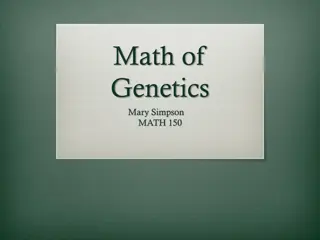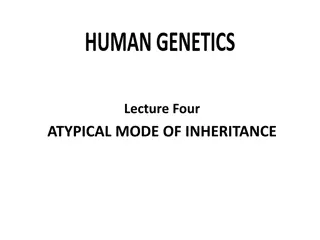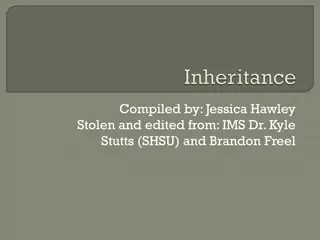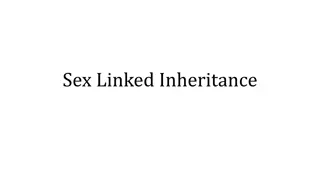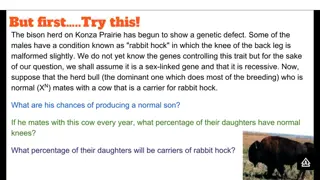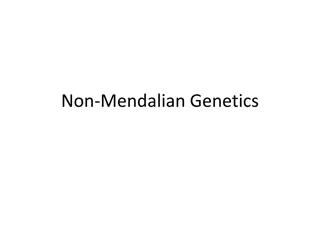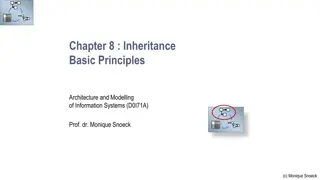Understanding Sex-Linked Inheritance in Genetics
Explore the concept of sex-linked inheritance, where traits are determined by genes on sex chromosomes. Learn about X-linked and Y-linked characteristics, the patterns of inheritance in males and females, and examples of sex-linked traits like Hemophilia and Color blindness. Understand the implications of criss-cross inheritance patterns and why males are more susceptible to sex-linked disorders. Delve into the classification of X-linked, Y-linked, and XY-linked genes in different organisms.
Download Presentation

Please find below an Image/Link to download the presentation.
The content on the website is provided AS IS for your information and personal use only. It may not be sold, licensed, or shared on other websites without obtaining consent from the author. Download presentation by click this link. If you encounter any issues during the download, it is possible that the publisher has removed the file from their server.
E N D
Presentation Transcript
lecture (6) Sex linked inheritance Dr. Dr. Aqeel M. Aqeel M. ali 2019 ali
Basic principles of heredity that Mendel discovered from his crosses among pea plants. A mendelian principle sex-linked characteristics determined by genes located on the sex chromosomes. Genes on the X chromosome determine X- linked. Characteristics. those on the Y chromosome determine Y-linked characteristics.
most sex-linked characteristics are X linked. (Because the Y chromosome of many organisms contains little genetic information) . Males and females differ in their sex chromosomes; so the pattern of inheritance for sex-linked characteristics differs from that exhibited by genes located on autosomal chromosomes. genes in the X chromosomes are represented twice in female (because female contains 2X chromosomes) once in male (because male has only one X chromosome).
genes which occur exclusively on the X chromosome (mammals, Drosophila, Melandrum, etc.) or on the analogous Z chromosome (in birds and other species with ZO or ZW mechanism of sex determination) arecalled X- or Z -linked genes. The genes which exclusively occur in Y chromosome are called holandricgenes. The inheritance of X or Z-linked and Y holandric genes is called sex-linked inheritance.
In XX XY type organisms, sex-linked genes can be classified into following three types: A. X-linked are localized in the non homologous sections of X- chromosome, and that have no corresponding allele in Y chromosome. B. Y-linked section of Y chromosome, and that have no alleles in X- chromosome. genes which are localized in the non-homologous The Y-linked genes are commonly known as holandric genes (Greek, holos = whole, and andros = man). C. XY-linked. homologous sections of X and Y chromosomes is performed by those genes are localized in
Characteristicsof Sex-linked Inheritance a. The pattern of is criss-cross. (The father passes the X linked allele of a trait to the daughters who pass it on to the grandsons. ( fathercannot pass a sex linked allele to a son directly ) b. The mothercan pass the allele of a trait to both daughterand son. c. Only homozygous females can express a recessive trait, while heterozygous female are carriers and do not express the trait. d. Males express the trait immediately ( because of the absence of a corresponding allele) why malessufferfrom sex linked disorders morethan females ? e. Most of the sex linked traits are recessive. Some examples include : Hemophilia ( Bleeder s disease), Daltinism ( Color blindness)
TheX-linked genes (X) contain genes that have no counterparts on the other kind of sex chromosome These genes, whether dominant or recessive, show their effects in the male phenotype , the types of X- linked genes as followes: The X-linked recessive genes: it more peculiar features criss-cross pattern of inheritance ( X-linked recessive gene is transmitted from P1 (father) to F2 male progeny (grandsons) through its F1 heterozygous females (daughters) show the following two different F1 and F2 results (ratios) in the reciprocal crosses. X-linked recessives can be detected in human pedigrees (also in Drosophila) through the following :
The X-linked recessive phenotype is usually found more frequently in the male than in the female. Because in mother and father bear the X-linked recessive allele (e.g., XA Xa XaY), whereas an affected male only mother carries gene. Further, if the recessive X-linked gene is very rare (i) affected female both (ii) None of the offspring of affected male will be affected, but all his daughters will carry , so one half of their sons (i.e., grandsons of F1 father) will beaffected . (iii Sons not affected with not pass the genealong to theiroffspring
2- DominantX-linked genes : * can be detected in human pedigrees (also in Drosophila) through the following clues : (a) It is more frequently found in the female than in the male. (b) affected males pass condition toall daughters but no sons (c) Females pass the condition (defective phenotype) on to one-half of theirsonsand daughters (d) fails to be transmitted to any son from a mother which did notexhibit the trait itself. In humans, X-linked dominantconditions rare ,examples : hypophosphatemia(vitamin D-resistantrickets). hereditary enamel hypoplasia (hypoplastic amelogenesis imperfecta), in which tooth s abnormally thin so that teeth appear small and rapidly down to thegums.
Exampleof Inheritance of X-Linked Recessive Genes The crisscross inheritance of recessive X- linked genes can be well understood by following Drosophila, man, moth and chikens etc: classical examples in 1. Inheritanceof X-Linked Gene for Eye Colour in Drosophila the gene forwhite eye colour is X-linked and recessive gene forred-eye colour. dominant It is discovered by Morgan in 1910. Following crosses between white eyed and red eyed Drosophila , criss-cross inheritance of gene forwhiteeyed color .
(a) Red eyed female White eyed male crossed with a mutant white eyed male Drosophila, all the F1 individuals irrespective of theirsex have red eyes P XRXR X XrY If a wild red eyed female Drosophila is XRXr, XRY F1 Red eyed female , Red eyed male When the red eyed male and red eyed female individuals of F1 are intercrossed, XRXr X XRY XRXR, XRY , XRXr XrY , Red eyed female, red eyed male, Red eyed female, white eyed male 3 red the F2 progeny is found to include an exclusively red eyed female population and a male population with 50 per cent red eyed individuals and 50 per cent white eyed individuals. Thus, F2 generation includes red eyed and white eyed individuals in the ratio of 3: 1. : 1whiteeyed
b) White eyed female Red eyed male. When a white eyed female Drosophila is crossed with a red eyed male Drosophila, all the female individuals in the F1 generation are red eyed XrXr x XRY XRXr XrY , Red eyed female , white eyed male When these red eyed female individuals and white eyed male individuals of F1 are intercrossed, XRXr x XrY XRXr, XRY, XrXr, XrY Red eyed female , Red eyed male , white eyed female , white eyed male the female population of F2 generation is found to include 50 per cent red eyed and 50 per cent white eyed flies. Similarly, the male population of F2 includes 50 per cent, red eyed and 50 percentwhiteeyed flies. on a sex chromosome alternates the sex from one generation to the next generation, i.e, the trait of whiteeyes transfers from P1 father to F1 daughterand from F1 daughterto F2 son. The results of these experiments, thus, are clearly indicating that the trait located
2. Inheritanceof X-Linked Recessive Genes in Humans In human more than 150 probable X-linked traits are known; most of these are recessives. Certain well known examples in humans are: red- green colour blindness ordaltonism, haemophiliaand Duchenne s musculardystrophy. Someotherexamplesof X-linked recessive traits include (1) (G6PD deficiency) in erythrocytes haemolytic anaemia during allergy reaction of persons for thedrugs such as or for the broad bean (Vicia faba), called favism; (2) night blindness ; (3) white frontal patch of hair.
(1) Colour blindness In human thecoloursensitivecells, thecones, in the retinaof eye. There are three different types of cones, each with its characteristic pigment that react moststrongly to red, green and violet light. The recessive form of this gene is incapable of producing the colour sensitivecones . homozygousrecessive females (XcXc) hemizygous recessive males (XcY) unable to distinguish between these two colours a dominant X- linked gene is necessary for the formation of The frequencyof women is much less blind man? (i) Marriage between colour-blind man & normal woman. produce normal male and female F1. (ii) Marriage between a F1 normal woman and normal male produce 2 n. female,1n.male and1 blind maleF2
2- Haemophilia ( bleedersdisease ) more common in men than women.. The person which contains the recessive gene for haemophillia lacks in normal clotting substance (thromboplastin) in blood so minor injuries cause continuous bleeding and ultimate death of the person dueto haemorrhages. This hereditarydisease reported by John Cotto of Philadelphia in 1803 in man. (a)HaemophiliaA. lack of antihaemophilic globulin (FactorVIII). four fifths of the casesof haemophilic are this type. (b) Haemophilia B. called christmasdisease defect in plasma thromboplasticcomponent (factor IX). milder form of haemophilia. X+Xh X+Y Parents : Normal mother(carrier) Normal father (X+) (Xh) (X+) (Y) Gametes: X+X+, X+Xh, X+Y XhY Progeny : , Normal daughter, Normal (carrier), Normal , Hemophilic
B. INHERITANCE OF Y-LINKED GENES Y chromosome pass directly from male to male. In man, Y-linked or holandric genes are transmitted directly from father to son Having hairy ears was once thought to bea Y-linked trait in humans, but that hypothesis has been discredited. , It little is known about genes that may beY-linked. This is no longer true., about three dozen genes were known to be Y-linked including: ASMTY, TSPY Y-Chromosome deletions are cause of male infertility. . deletion in the DAZ gene cause azoospermia
SEX-INFLUENCED GENES Sex influenced genes are those whose dominance is influenced by the sex of the bearer. Thus, male and female individuals may be similar for a particular trait but give different phenotypic expressionsof thesame trait.. Example : 1- In man the baldness may occur due to disease, radiation or thyroid defects but in some families balld ness is found to be inherited trait. In such inherited baldness the hairs gradually become thin on head top, leaving ultimately a fringe of hair low on the head and commonly known as pattern baldness. The gene B for baldness is found to bedominant in males and recessive in females.
2- In sheep the genes for the development of horns is dominant in males and recessive in female.
SEX-LIMITED GENES Sex-limited genes are autosomal genes whose phenotypic expression is determined by the presence or absence of one of the sex hormones. Their phenotypic effect is limited to one sex or other. In other words, the penetrance of a sex-limited gene in one sex remain zero. Sex-limited genes are responsible for sexual dimorphism, which is a phenotypic (directly observable) difference between males and females of the same species. These differences can be reflected in size, color, behavior Example 1. The bulls have genes for milk production which they transmit to their daughters, but they or their sons are unable to express this trait. The production of milk is, therefore, limited to variable expression only in the female sex. 2. Beard development in human beings is a sex limited trait as men normally have beards, whereas women normally do not. Likewise, the genes for male voice, body hair and physique are autosomal in human beings, but they are expressed only in the presence of androgenswhich areabsent in females. 3. In chicken the recessive gene (h) for cock feathering is male sex-limited (i.e., it is penetrantonly in male environment)


